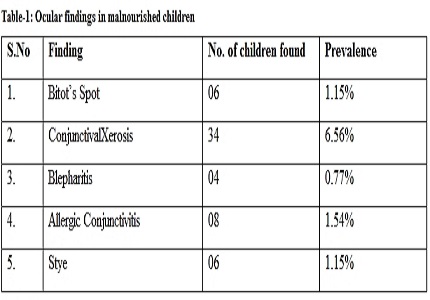A clinical study of prevalence of ocular manifestations in malnourished children attending Anganwadi centers in urban slum areas
Abstract
Aim: A clinical study of prevalence of ocular manifestations in malnourished children attending anganwadi centers in urban slum areas.
Material & Method: A cross sectional study was carried out in Anganwadi centers of urban slum area, with children of age group 0 – 6 years. All children underwent detailed systemic and ocular examination and were graded for malnutrition according to IAP classification. The results were analysed statistically.
Results: In our study the prevalence of ocular manifestations is 9.6% (50). Prevalence of malnutrition is 18.53% (96). Out of 96 malnourished, 56 children (58.33%) belong to grade I malnutrition, out of which 16 children (32%) had ocular manifestation, which is total ocular manifestation in all the grades of malnutrition. So, ocular manifestation in malnourished children is 32%. Overall ocular involvement was seen in 50 children out of 518 children examined, with overall prevalence of 9.65%. Thereis significant difference of ocular involvement between malnourished and wellnourished (p value – 0.017).
Conclusion: Overall prevalence of malnourished children wasfound to be very less at anganwadi centers in our study. This may be probably due to the timely vaccination of children and the nutritional supplements being provided to them at Anganwadi centers through various national programmes.
Downloads
References
Arlappa N, Balakrishna N, Laxmaiah A, Raghu P, Rao VV, Nair KM, Brahmam GN. Prevalence of vitamin A deficiency and its determinants among the rural pre-school children of Madhya Pradesh, India. Ann Hum Biol. 2011 Mar;38(2):131-6. doi: https://doi.org/10.3109/03014460.2010.498794. Epub 2010 Jul 15.
Rahi JS, Sripathi S, Gilbert CE, Foster A. Childhood blindness in India: causes in 1318 blind school students in nine states. Eye (Lond). 1995;9 ( Pt 5):545-50.
Desai S, Desai R, Desai NC, Lohiya S, Bhargava G, Kumar K. School eye health appraisal. Indian J Ophthalmology. 1989;Vol 37: Issue 4;pages173-175.
Paul VK,Bagga A, editors. GHAI Essential Paediatrics.8thedition.Delhi:CBS Publishers,2013.Table no.6.7,IAP classification of malnutrition;p97.
Dole K, Gilbert C, Deshpande M ,Khandekar R. Prevalence and Determinants of Xerophthalmia in Pre School Children in Urban Slums, Pune, India- A Preliminary Assessment. Journal Ophthalmic Epidemiology,Vol 16,2009-issue 1 ;8-14.
Gupta Y, Sukul RR, Gupta M, Phougat A, Jain R, Varshney A. School eye survey in rural population in UP, India. Nepal J Ophthalmol. 2011 Jan-Jun;3(1):78-9. doi: https://doi.org/10.3126/nepjoph.v3i1.4282.
Laxmaiah A, Nair MK, Arlappa N, Raghu P, Balakrishna N, Rao KM, Galreddy C, Kumar S, Ravindranath M, Rao VV, Brahmam GN. Prevalence of ocular signs and subclinical vitamin A deficiency and its determinants among rural pre-school children in India. Public Health Nutr. 2012 Apr;15(4):568-77. doi: https://doi.org/10.1017/S136898001100214X. Epub 2011 Sep 2.
Moore DB, Shirefaw W, Tomkins-Netzer O, Eshete Z, Netzer-Tomkins H, Ben-Zion I. Prevalence of xerophthalmia among malnourished children in rural Ethiopia. IntOphthalmol. 2013 Oct;33(5):455-9. doi: https://doi.org/10.1007/s10792-013-9715-9. Epub 2013 Jan 25.
Gopaldas T, Gujral S, Abbi R. Prevalence of xerophthalmia and efficacy of vitamin A prophylaxis in preventing xerophthalmia co-existing with malnutrition in rural Indian children. J Trop Pediatr. 1993 Aug;39(4):205-8.
Gorstein J, Shreshtra RK, Pandey S, Adhikari RK, Pradhan A. Current statusof vitamin A deficiency and the NationalVitamin AControlProgram in Nepal: results of the 1998NationalMicronutrientStatusSurvey. AsiaPac JClinNutr.2003;12(1):96-103.
Arlappa N, Laxmaiah A, Balakrishna N, Harikumar R, BrahmamGN.Clinical and sub- clinical vitamin A deficiency among rural pre-school children of Maharashtra, India. Ann Hum Biol. 2008 Nov-Dec;35(6):606-14. doi: https://doi.org/10.1080/03014460802380778.



 OAI - Open Archives Initiative
OAI - Open Archives Initiative


